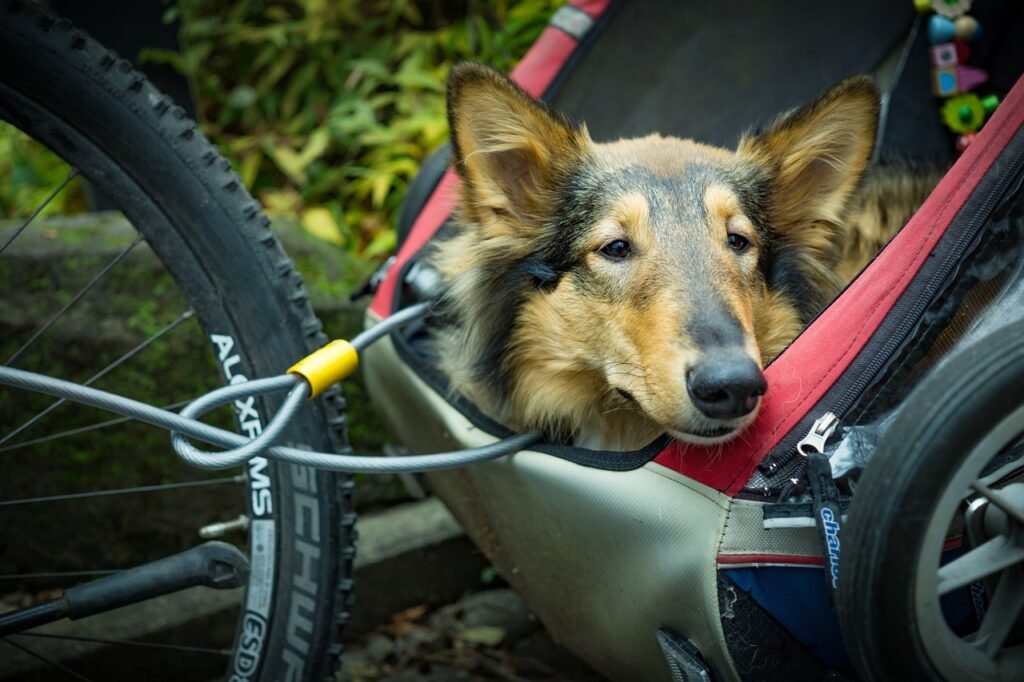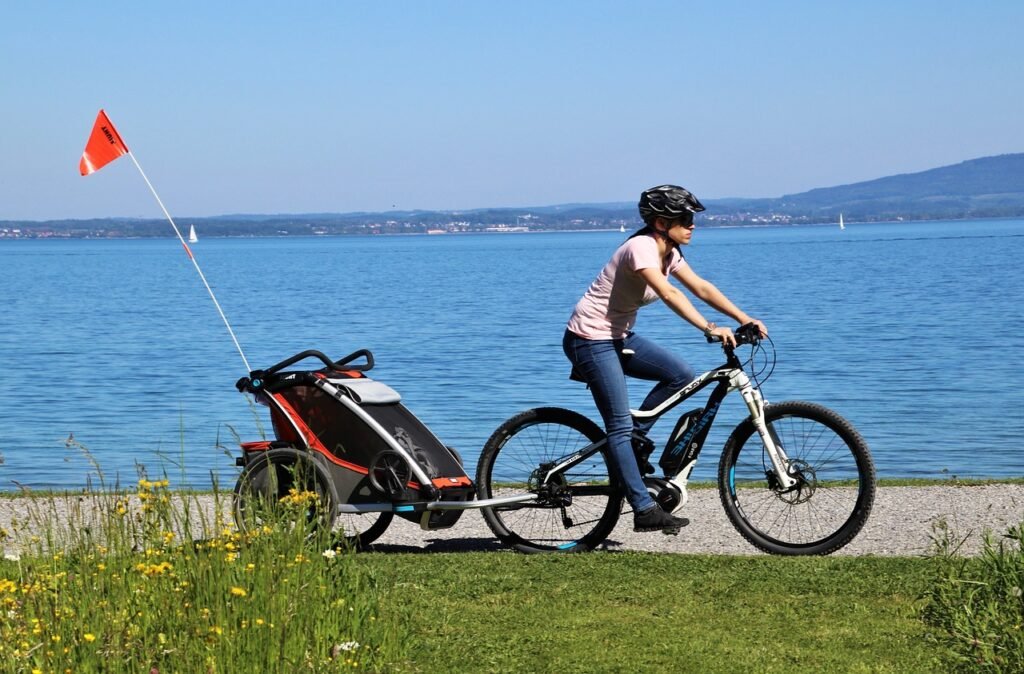Can I Use A Bike Trailer To Transport Children Or Cargo Safely?
If you’re wondering whether it’s safe to use a bike trailer to transport your little ones or precious cargo, you’ve come to the right place. Whether you’re an avid cyclist or just considering this mode of transportation, it’s important to ensure the safety of your loved ones or valuables. In this article, we will explore the question of whether a bike trailer is a secure and reliable option for transporting children or cargo, providing you with valuable insights and considerations to make your biking adventures worry-free. So, let’s pedal through and find out!
Choosing a Bike Trailer
When it comes to choosing a bike trailer, there are several factors to consider. The type of bike trailer, size and weight capacity, and safety features are all important considerations for ensuring a safe and comfortable ride for both you and your passengers or cargo.
Type of Bike Trailer
There are two main types of bike trailers: single-wheel trailers and two-wheel trailers. Single-wheel trailers are designed for off-road use and offer better maneuverability, making them ideal for biking on rugged terrains. On the other hand, two-wheel trailers provide more stability and are better suited for smooth surfaces and urban environments.
Before making a decision between the two, consider your biking needs and the type of terrain you will frequently encounter. Assessing your priorities will help you determine which type of bike trailer is the best fit for you.
Size and Weight Capacity
Another important consideration when choosing a bike trailer is the size and weight capacity. Bike trailers come in different sizes to accommodate varying loads. Consider the number and size of children you will be transporting or the size and weight of the cargo you plan to carry.
It’s crucial to choose a bike trailer that can comfortably and safely accommodate both your passengers or cargo and your bike’s towing capacity. Exceeding the weight limits specified by the manufacturer can compromise the stability and performance of the trailer and pose a safety risk.
Safety Features
When it comes to the safety of your passengers or cargo, a bike trailer with proper safety features is essential. Look for trailers equipped with a sturdy frame, reliable brakes, and ample protective barriers that prevent your passengers or cargo from falling out.
Ensure that the trailer has a secure and adjustable harness system to keep your children safely seated and protected. Reflective elements and bright-colored fabric also enhance visibility, making you and your trailer more noticeable to motorists.
Safety Guidelines
Once you have chosen the right bike trailer, it’s essential to follow safety guidelines to ensure a safe and enjoyable experience for everyone involved.
Age and Size of Children
Before seating your child in a bike trailer, consider their age and size. Most bike trailers have age and weight restrictions, so it’s crucial to adhere to these guidelines. Ensure that your child can comfortably fit within the trailer’s seating area and is securely harnessed.
Proper Seating and Harnessing
Proper seating and harnessing are essential for the safety of your child. Ensure that your child is seated comfortably and securely strapped into the harness. Pay attention to any prompts or instructions provided by the bike trailer manufacturer regarding proper seating and harnessing.
Cargo Weight Limit
If you are using a bike trailer to transport cargo, it’s crucial to be aware of the weight limit specified by the manufacturer. Exceeding this limit can compromise the stability and performance of the trailer, making it unsafe to use. Always distribute the cargo properly within the trailer and secure it to prevent shifting during rides.

Preparing Your Bike and Trailer
Before you embark on any bike trailer journey, it’s important to ensure that both your bike and the trailer are in proper working condition.
Proper Bike Maintenance
Regular bike maintenance is crucial for a safe and smooth ride. This includes checking the brakes, tires, and gears for any signs of wear or damage. Ensure that your bike is well-lubricated and that all components are properly tightened. If you are unsure about performing maintenance yourself, take your bike to a professional for a thorough inspection.
Attaching the Trailer Correctly
Properly attaching the bike trailer to your bike is essential for safety. Follow the manufacturer’s instructions carefully, ensuring that the connection is secure and stable. Check that all attachment points are properly locked, and give the trailer a gentle tug to ensure it is securely attached.
Securing the Cargo
If you are transporting cargo in the bike trailer, it’s important to secure it properly. Use bungee cords or straps to ensure that the cargo is tightly secured and won’t shift during the ride. Ensure that the cargo is evenly distributed within the trailer to maintain stability.
Safe Riding Practices
In addition to ensuring the safety of your bike trailer and its contents, following safe riding practices is crucial for a safe and enjoyable ride.
Choosing Suitable Routes
When riding with a bike trailer, it’s important to choose routes that are suitable for both you and your trailer. Avoid busy roads with heavy traffic and opt for dedicated bike paths or quieter streets whenever possible. Consider the terrain and choose routes that are smooth and without steep inclines or declines.
Maintaining Visibility
Visibility is key to staying safe on the road. Ensure that both you and your bike trailer are highly visible to motorists by equipping your bike trailer with reflective elements and bright-colored flags. Wearing bright clothing and using lights during low-light conditions further enhance your visibility.
Adhering to Traffic Rules
Always observe and follow traffic rules and regulations. This includes stopping at stop signs and traffic lights, signaling your intentions, and obeying speed limits. Remember that you are responsible for the safety of your passengers or cargo, so it’s important to be a responsible and vigilant cyclist.

Practical Tips for Transporting Children
Transporting children in a bike trailer requires additional considerations to ensure their comfort and safety.
Communicating with your child
Maintaining clear communication with your child while biking is important. Establish simple signals or hand gestures to indicate when you will be stopping or turning. This will help your child anticipate and react accordingly, making the ride smoother and safer for both of you.
Making Regular Stops
Biking with children can be tiring for them, so it’s important to make regular stops to give them a chance to stretch their legs and take a break. Plan your route with rest stops in mind, and be mindful of your child’s comfort and well-being throughout the ride.
Using Weather Protection
To protect your child from the elements, ensure that your bike trailer is equipped with appropriate weather protection. This can include a rain cover to shield them from rain or a sunshade to provide shade during hot and sunny rides. Regularly check the weather forecast before embarking on a ride to ensure optimal comfort and safety for your child.
Tips for Transporting Cargo Safely
When using a bike trailer to transport cargo, it’s important to take additional precautions to ensure the safety of the items you are carrying.
Distributing Weight Properly
Proper weight distribution within the trailer is crucial for maintaining stability. Place heavier items closer to the bottom and evenly distribute the weight from side to side. Avoid placing all the weight on one side, as it can affect the balance and make the trailer more prone to tipping over.
Securing the Cargo Inside the Trailer
To prevent your cargo from shifting during the ride, secure it firmly within the trailer. Use straps or bungee cords to fasten the cargo to the trailer’s frame, ensuring that it is snug and won’t move around. Always double-check the security of your cargo before starting your ride.
Protecting Fragile Items
If you are transporting fragile or delicate items, take extra precautions to protect them from damage. Wrap fragile items in protective padding or bubble wrap and secure them within the trailer to minimize the risk of breakage. Be mindful of the terrain you will be biking on and adjust your route if necessary to avoid excessive vibrations or bumps.
Additional Safety Considerations
In addition to the specific guidelines for transporting children or cargo, there are some general safety considerations that apply to all bike trailer users.
Weather Conditions
Be mindful of weather conditions before embarking on a bike trailer ride. Strong winds, rain, or snow can affect the stability and safety of your bike trailer. If weather conditions are unfavorable or potentially hazardous, it’s best to postpone your ride for another day.
Using Reflectors and Lights
Enhancing your visibility on the road is essential for safety. Ensure that your bike trailer is equipped with reflectors and lights to make you more visible to motorists, especially during low-light conditions or at night. Regularly check the function and condition of these safety features to ensure optimal performance.
Keeping a Safe Distance
Maintain a safe distance from other vehicles while riding with a bike trailer. This will give you ample time to react to any sudden changes in traffic and avoid potential accidents. Be especially cautious when passing parked cars or navigating tight spaces, allowing for extra space to maneuver your bike trailer safely.
Maintenance and Inspections
Regular maintenance and inspections of your bike trailer are crucial for ensuring its continued safety and performance.
Regular Cleaning and Lubrication
Like any outdoor equipment, bike trailers are exposed to dirt, dust, and other elements that can affect their performance over time. Regularly clean your bike trailer, paying special attention to the wheels, brakes, and frame. Apply lubrication to moving parts to minimize friction and ensure smooth operation.
Checking for Wear and Tear
Inspect your bike trailer regularly for any signs of wear or damage. Check the tires for proper inflation and signs of wear, ensuring that they are in good condition. Examine the frame and attachment points for cracks or damage. If you notice any issues, address them promptly by repairing or replacing the affected parts.
Maintaining Tire Pressure
Proper inflation of the trailer tires is important for stability and performance. Check the recommended tire pressure specified by the manufacturer and ensure that the tires are inflated accordingly. Regularly monitor and adjust the tire pressure as needed to maintain optimal performance.
Trailer Safety Standards
When selecting a bike trailer, it’s important to ensure that it complies with safety regulations and meets certification standards.
Compliance with Safety Regulations
Check that the bike trailer you choose complies with safety regulations applicable in your country or region. This ensures that the trailer meets minimum safety requirements and has undergone testing to ensure its safety and reliability.
Certification Standards
Look for bike trailers that have undergone certification testing by reputable organizations or safety standards bodies. Certification provides an added assurance of the trailer’s safety and quality, as it indicates that it has met specific standards for performance and durability.
Checking for Recalls
Before purchasing a bike trailer, check for any recalls or safety notices issued by the manufacturer. This information is usually available on the manufacturer’s website or through consumer product safety organizations. Staying informed about any potential safety issues allows you to make an informed decision and ensure the safety of your passengers or cargo.
Conclusion
Using a bike trailer to transport children or cargo can be a convenient and enjoyable way to get around. However, ensuring the safety of both your passengers or cargo and yourself is of utmost importance. By choosing the right bike trailer, following safety guidelines, and practicing responsible riding habits, you can enjoy safe and worry-free bike trailer adventures. Regular maintenance and proper adherence to safety standards will further enhance the longevity and safety of your bike trailer, allowing you to make the most of your biking experiences while keeping everyone safe.
